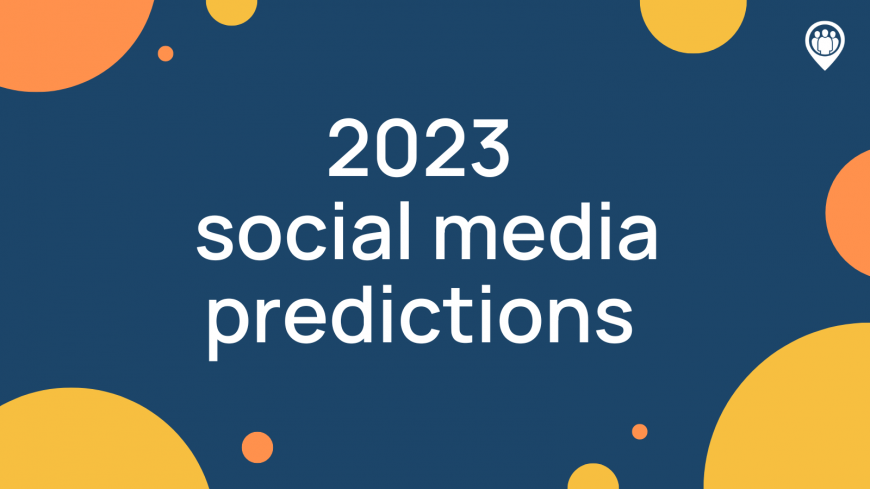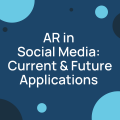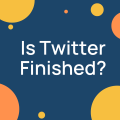2023 social media predictions
Richard Knowles posted on 22 November 2022

2022 has seemingly flown by, with plenty of things to keep us on our toes post Covid.
But what does 2023 hold for everyone, in particular using our social media channels.
Will Elon Musk’s takeover of Twitter create opportunity for that platform or is it a case of everyone simply surviving?
One thing is for sure, 2023 will see everything focused on digital-first, with Artificial Intelligence (AI), Augmented Reality (AR) and online shopping being taken very seriously by brands and how they entertain and engage with customers.
Those customers aren’t moving away from social platforms, merely consuming them differently, so brands need to embrace every digital-based support available, in order to reach them.
We take a look at the top six trends we think brands will focus on in 2023.
The growth of nano-influencer marketing
While the main aim of using an ‘influencer’ is to sell products and/or services, it is not the only purpose.
Today, self-aware customers wish to engage with brands and influencers that bring in genuineness, substance and confidence to the marketing mix.
The danger, of course, is fake influencers and keeping them away from a brand, to ensure a well-thought out social strategy is not damaged by an endless game of trying to get the most likes.
In essence, brands should look at how they can work with nano-influencers (1,000-5,000 followers), to follow a much more community-led method.
In 2023 and beyond, this will bring a value to the strategy that can symbolise a brand’s voice, tone and values, as opposed to simply settling for a race to the top of the popularity stakes – likes anyone?
The reason? Well, amongst other things, nano-influencers are often seen enthusiastically interacting with consumers, responding to posts, offering more personal and distinctive content.
This can provide long-term consumers to a brand, who can then become mini advocates themselves.
Nano-influencers generally drive better customer engagement and therefore can have a greater impact on a brand’s audience.
In 2023, the focus will constantly be on quality, rather than quantity, which is why nano-influencers are the key to unlocking more valuable assets and, in turn, revenue.
AI and AR will increase in use and value
The adoption of technology on social channels is huge, and will continue to be so; whether it’s AI or AR, social media users often desire attractive and new experiences.
Just take a look at Facebook’s Horizon. The social media platform’s own social virtual reality world, giving people the space to explore products and services, and play games.
With the rise in mentions of predictive analytics this year, we’re bound to see professionals across social media and marketing increasingly incorporate AI-powered predictive analytics within their work.
This will help in predicting future trends across the industry, and more accurately.
So combining both AI and AR, brands can deliver a big impact on sales, while also giving consumers what they want and need.
Just remember, discovering inventive and appealing ways to connect with consumers on social media platforms can often be a turning point for small and big businesses alike.
Conversations will be livened up by chatbots
Brands need to listen to their customers to be able to understand any sticking points in the sales process, to help provide simple and immediate solutions.
This is where chatbots come in, to assist brands in reaching a bigger global audience, every minute of every day.
To many it’s an amazing tool that can place an audience at the centre of a brand’s customer experience.
Chatbots becoming intelligent mean they can multi-task and address customer queries, freeing up time for social media operators to focus on more complex tasks.
That’s right, instinctive chatbot social media marketing is with us and will continue to grow.
Unprecedented levels of customer service
While customer service is considered a widely used term for marketing teams across the world, it’s often misunderstood by many people.
Having an FAQ on a website or as a leaflet is simply inadequate in a world where customers expect a high level of service.
The relationship between a brand and its customers has never been more important and it means many businesses need to urgently review their customer service strategy.
But what can a brand do to compete against rivals that are improving their customer service or offering one at amazing levels?
Building a deeper and more meaningful relationship with customers, one that is based on mutual trust and loyalty, is imperative.
Levels of customer service need to be out of this world, good or very good won’t do anymore.
So where can a business improve those relationships? Well, one channel provides an excellent platform to do so – Twitter. Of course, this is subject to the ‘Musk-effect’.
This is the place many people go to. According to research, 79% of Twitter users like to discover what’s new, making it the top platform for discovery.
Which makes it a great place to engage with people, showcase customer service and reach a wider target audience, to deliver long-term brand affiliation with existing and new customers.
Organic growth
One of the aftermaths of the pandemic is seeing the constant changing of the habits of consumers.
It’s likely to consign persona marketing to the redundancy heap, with brands looking to target their wider communities.
This will mean brands concentrating on community eco-systems in order to generate organic connections and relationships.
The likes of Signal, Geneva and Discord, so private social media platforms, will be the ones to help facilitate this because they can support influencers and brands in creating friendlier links to their audiences.
Social platforms will integrate online shopping
Providing social ads with an unbroken route to online shopping is very en vogue. Of course it is; it’s fast, convenient and creates good profit margins.
Put simply, brands place a direct advert on a social media channel to promote a product; the customer can then be communicated with directly without leaving the channel, giving brands revenue almost immediately.
By utilising social ads means brands can reach out to an increasing number of customers at the right time and in the right place. Expect them to be used in ever increasing numbers in 2023.
Just think about Facebook’s Marketplace. It’s used by 800 million people in 70 different countries every month.
It gives a continually increasing audience of quality buyers and helps brands target the right people.
With product organisation, call to action buttons and simple to use ad formatting, Facebook Marketplace should be on a brand’s list of places to spend its ad budget.
Of course don’t forget Instagram’s ‘checkout with Instagram’ feature. It gives users the ability to view products from posts about shopping, without them moving away from the app.
For advertisers it means the platform allows brands to put ‘checkout tags’ on product-related stories/posts, to give buyers a seamless, one-click, buying experience.
Good luck in 2023!







